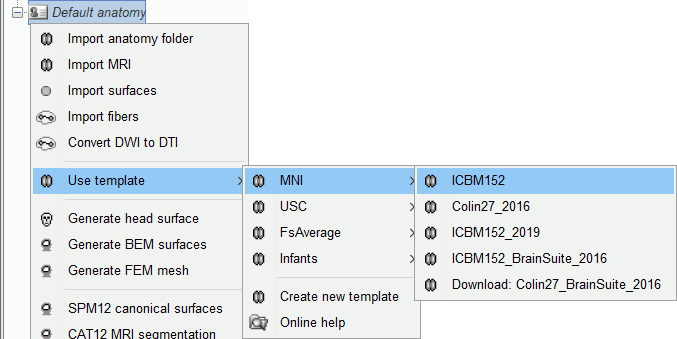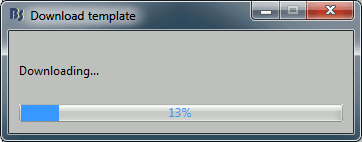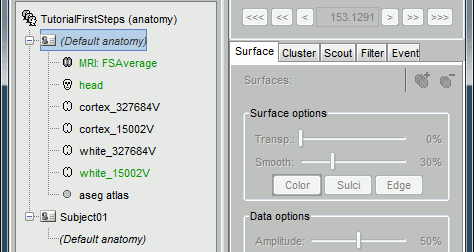|
Size: 4428
Comment:
|
Size: 5046
Comment:
|
| Deletions are marked like this. | Additions are marked like this. |
| Line 6: | Line 6: |
| == Possible uses == * There is always a copy of the Colin27 anatomy in every protocol you create * It can be used as a replacement for the subject's anatomy if you don't have the MRI scan * It is used for group studies: the individual source maps are first projected on a standard brain |
== Changing the default anatomy == When you create a new protocol, the program makes a copy of the ICBM152 or Colin27 anatomy and sets it as the default for the protocol. It means that you will be able to use this template brain as a substitute for the subjects without an individual MRI, or as the common brain for group analysis. |
| Line 11: | Line 9: |
| == Changing the default anatomy [TODO] == ADD IMAGES FOR ALL THE MODELS + DETAILS OF WHAT IS AVAILABLE |
Other sets of MRI+surfaces are available to replace the Colin27 anatomy. Right-click on ''(Default anatomy)'' > Use template. If a package is not currently available on your system, it will be downloaded from the Brainstorm website and saved in $HOME/.brainstorm/templates. |
| Line 14: | Line 11: |
| When you create a new protocol, the program makes a copy of the Colin27 anatomy and sets it as the default for the protocol. It means that you will be able to use the Colin27 brain as a substitute for the subjects without an individual MRI, or as the common brain for group analysis. | . {{attachment:changeDefault.gif|changeDefault1.gif|height="266",width="348"}} |
| Line 16: | Line 13: |
| Other sets of MRI+surfaces are available to replace the Colin27 anatomy. Right-click on ''(Default anatomy)'' > Use template. If a package is not currently available on your system, it will be downloaded from the Brainstorm website and saved in $HOME/.brainstorm/templates. The available options are: | If you click on any of the download options, it downloads it into your $HOME/.brainstorm/templates folder, then the list of files in the (default anatomy) folder is replaced with the new template. . {{attachment:changeDefault2.gif||height="90",width="228"}} {{attachment:changeDefault3.gif||height="187",width="352"}} == Group analysis == When performing a group analysis with multiple subjects for which you have the individual MRI scans, you need to project the sources estimated on each subject on a common template, as explained in this tutorial: [[Tutorials/CoregisterSubjects|Group analysis]]. For accurate registration between different brains (from a subject to a template or between subjects), you need to use a template that was generated using the '''same program''' as the one you used for running the segmentation of all the subjects of your studies. You can use either BrainSuite or FreeSurfer for processing the MRIs or your subjects, but you need to use a template that matches this choice in order to use the accurate registration methods. == FreeSurfer templates == Available options: |
| Line 19: | Line 28: |
| * '''Colin27_2012''': Previous version of the default anatomy distributed with Brainstorm | |
| Line 21: | Line 29: |
| Line 22: | Line 31: |
| * '''Infant7w''': 7-week infant brain with the antomical atlas presented in [[http://www.sciencedirect.com/science/article/pii/S105381191400411X|(Kabdebon et al. 2014)]]. * '''Oreilly_1y''': 1 year old infant brain with Tzourio-Mazoyer surface atlas ([[http://journals.plos.org/plosone/article?id=10.1371/journal.pone.0127322|Li et al. 2015]], [[http://journals.plos.org/plosone/article?id=10.1371/journal.pone.0018746|Shi et al. 2011]]): http://neuroimage.usc.edu/forums/showthread.php?2123-Atlas-for-1-year-old-babies |
|
| Line 31: | Line 38: |
| * FreeSurfer surface-based atlases: Desikan-Killiany, Destrieux, Brodman, Mindboggle<<BR>>(plus Yeo2011 and PALS for FSAverage only) | * FreeSurfer surface-based atlases: Desikan-Killiany, Destrieux, Brodmann, Mindboggle<<BR>>(plus Yeo2011 and PALS for FSAverage only) |
| Line 33: | Line 40: |
| The atlases will be discussed in the following tutorials. For more information on the interactions between FreeSurfer and Brainstorm: [[Tutorials/LabelFreeSurfer|read this tutorial]]. | For more information on the interactions between FreeSurfer and Brainstorm: [[Tutorials/LabelFreeSurfer|read this tutorial]]. |
| Line 35: | Line 42: |
| {{attachment:changeDefault.gif|changeDefault1.gif}} | == BrainSuite templates == Available options: |
| Line 37: | Line 45: |
| If you click on any of the download options, it downloads it into your $HOME/.brainstorm/templates folder: | == BrainVISA templates == Note that the BrainVISA-based templates '''do not allow any accurate registration''' procedure. |
| Line 39: | Line 48: |
| {{attachment:changeDefault2.gif}} Then the list of files in the (default anatomy) folder is replaced with the new template. {{attachment:changeDefault3.gif}} |
* '''Colin27_2012''': Previous version of the default anatomy distributed with Brainstorm. * '''Infant7w''': 7-week infant brain with the antomical atlas presented in [[http://www.sciencedirect.com/science/article/pii/S105381191400411X|(Kabdebon et al. 2014)]]. * '''Oreilly_1y''': 1 year old infant brain with Tzourio-Mazoyer surface atlas ([[http://journals.plos.org/plosone/article?id=10.1371/journal.pone.0127322|Li et al. 2015]], [[http://journals.plos.org/plosone/article?id=10.1371/journal.pone.0018746|Shi et al. 2011]]): http://neuroimage.usc.edu/forums/showthread.php?2123-Atlas-for-1-year-old-babies |
Using the anatomy templates
Author: Francois Tadel
Contents
Changing the default anatomy
When you create a new protocol, the program makes a copy of the ICBM152 or Colin27 anatomy and sets it as the default for the protocol. It means that you will be able to use this template brain as a substitute for the subjects without an individual MRI, or as the common brain for group analysis.
Other sets of MRI+surfaces are available to replace the Colin27 anatomy. Right-click on (Default anatomy) > Use template. If a package is not currently available on your system, it will be downloaded from the Brainstorm website and saved in $HOME/.brainstorm/templates.
If you click on any of the download options, it downloads it into your $HOME/.brainstorm/templates folder, then the list of files in the (default anatomy) folder is replaced with the new template.
Group analysis
When performing a group analysis with multiple subjects for which you have the individual MRI scans, you need to project the sources estimated on each subject on a common template, as explained in this tutorial: Group analysis.
For accurate registration between different brains (from a subject to a template or between subjects), you need to use a template that was generated using the same program as the one you used for running the segmentation of all the subjects of your studies.
You can use either BrainSuite or FreeSurfer for processing the MRIs or your subjects, but you need to use a template that matches this choice in order to use the accurate registration methods.
FreeSurfer templates
Available options:
Colin27: Average of 27 scans of the same head, processed with FreeSurfer 5.3: more information
ICBM152: Non-linear average of 152 subjects, processed with FreeSurfer 5.3: more information
FSAverage: Average of 40 subjects using a spherical averaging described in (Fischl et al. 1999).
It is the default FreeSurfer brain: please register here if you are using it.
More images: http://neuroimage.usc.edu/brainstorm/Tutorials/LabelFreeSurfer#FSAverage_template
They all include the following information:
- T1 MRI volume
- Cortex surface: high-resolution (~300.000 vertices) and low-resolution (15.000 vertices)
- Head surface: based on the head used for FSAverage in the MNE software
FreeSurfer spherical registration of each hemisphere, with which we can co-register the individual brains processed with FreeSurfer with the selected default anatomy
FreeSurfer surface-based atlases: Desikan-Killiany, Destrieux, Brodmann, Mindboggle
(plus Yeo2011 and PALS for FSAverage only)
For more information on the interactions between FreeSurfer and Brainstorm: read this tutorial.
BrainSuite templates
Available options:
BrainVISA templates
Note that the BrainVISA-based templates do not allow any accurate registration procedure.
Colin27_2012: Previous version of the default anatomy distributed with Brainstorm.
Infant7w: 7-week infant brain with the antomical atlas presented in (Kabdebon et al. 2014).
Oreilly_1y: 1 year old infant brain with Tzourio-Mazoyer surface atlas (Li et al. 2015, Shi et al. 2011): http://neuroimage.usc.edu/forums/showthread.php?2123-Atlas-for-1-year-old-babies
Modify the default MRI fiducials
The fiducial points (Nasion, LPA, RPA) used in your recordings might not be the same as the ones used in the anatomy templates in Brainstorm (Colin27, ICBM152, FSAverage). By default, the LPA/RPA points are defined at the junction between the tragus and the helix, as represented with the red dot in the Coordinates systems page.
If you want to use an anatomy template but you are using a different convention when digitizing the position of these points, you have to modify the default positions of the template with the MRI Viewer.
- Go to the anatomy view
In (default anatomy), right-click on the MRI > Edit MRI
- Modify the position of the fiducial points to match your own convention
- Click on [Save], it will update the surfaces to match the new coordinate system



